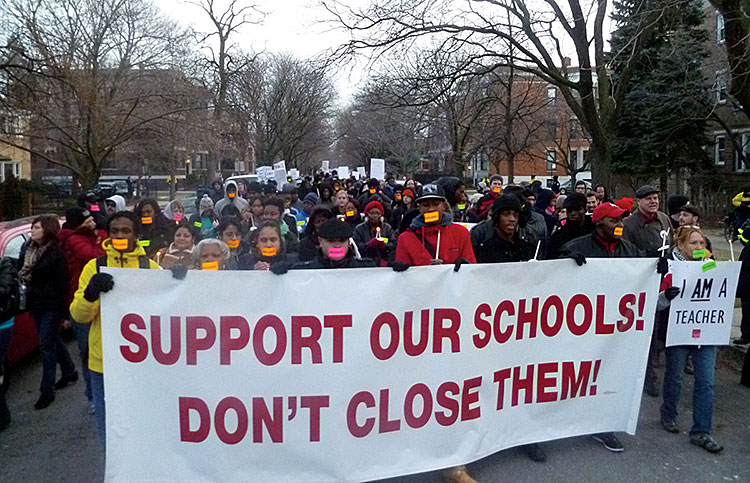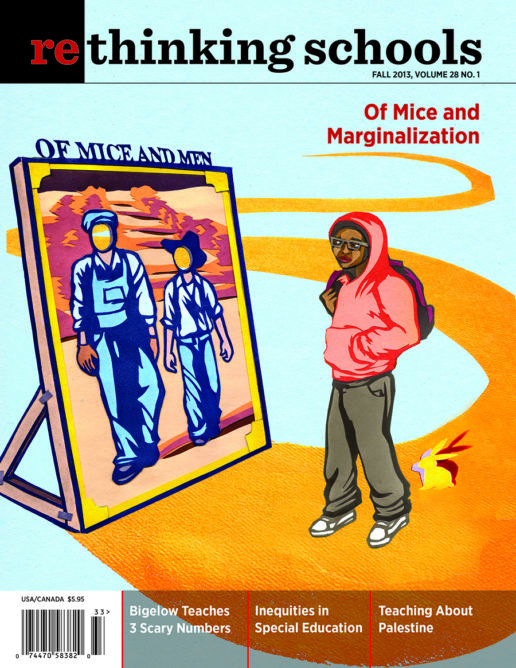Clear-Cutting Our Schools

No single policy reflects the bankruptcy of current education reform politics more than the mass closings of public schools. From Chicago to Washington, D.C., to New Orleans, Detroit, and Philadelphia, these mass closings lay waste to communities, negatively impact children’s lives, and help to dismantle not just public education but also the broader public sector, weakening organized labor and opening up the public space to commercial penetration and profit.
City by city, any number of excuses have been employed to justify these attacks. Private foundations, including Broad, Dell, and Walton, wield their enormous wealth and influence. Broad’s School Closure Guide has made its rounds through the education reform movement with cities like Chicago lifting its recommendations almost wholesale. Along with budget cuts, testing, and charters, school closings are part of the corporate reform playbook assaulting our schools.
Once school closings start, they simply do not stop. New York City has closed more than 140 public schools since 2002. Chicago capped almost a decade of closing more than 100 schools with its 49-school closure this year. After closing 23 schools, Washington, D.C., is closing 15 more. Pittsburgh has had four rounds of school closures in the past decade, amounting to a total decrease of 41 percent.
It’s not that most big city school systems are shrinking. All across the country, mass public school closings go hand in hand with expansion of charter and other nonpublic options (see “Charter Schools and the Future of Public Education,” p. 42). Since 2009, nearly 4,000 public schools have closed nationwide, while the number of charters has grown by 50 percent.
This isn’t about “right-sizing.” It’s a purposeful and deliberate transfer of dollars from a public system into one that is largely privately managed. It is a strategy for shrinking and dismantling public education, not improving it. Consider these facts:
No achievement gains: Numerous studies find no significant difference in academic quality between closing schools and the new schools receiving displaced students. Last spring, Philadelphia closed 24 public schools. More than 80 percent of the dislocated students will transfer to a school no better than the one they attended. In Washington, D.C., then-Chancellor Michelle Rhee closed 23 schools and sent students to schools with lower test scores on average than the ones they had attended. In a 2013 report for Broader, Bolder Approach to Education, Elaine Weiss and Don Long concluded:
School closures [in Chicago, New York, and Washington, D.C.] did not send students to better schools or save school districts money. . . . Most students whose schools were closed went to other schools with even lower test scores, and the disruption (some had multiple moves) was exacerbated by longer commutes and spikes in gang violence as established lines were crossed.
Disparate impact: School closures overwhelmingly target low-income black neighborhoods. Ten cities, including Philadelphia, Chicago, Newark, and New Orleans, recently filed civil rights complaints with the U.S. Department of Education about the disparate racial impact of school closures. In addition, many schools targeted for closure have had high percentages of special needs students. In Philadelphia, for example, one closing high school with a 30 percent special education population merged with another with a 33 percent special education population. The district average is 14 percent.
Questionable monetary savings: A 2012 Pew study of six school districts found that school officials frequently overestimate cost savings. In early May, Chicago officials admitted they may have overestimated savings from school closures by at least $122 million. Washington, D.C., reported that 23 school closings had not only failed to reap any savings, but had actually cost the district nearly $40 million.
Negative academic, physical, and psychological impact: In many cases, school closings have resulted in dramatic negative consequences for the affected students. The Urban Youth Collaborative followed students at 21 closing high schools in New York City. According to Weiss and Long, they found that “discharge and dropout rates Ôskyrocketed’ between the year a school was slated for closure and the year it closed,” from 25 to 70 percent at one NYC high school, and from 33 to 55 percent at another. Chicago studies have noted increases in danger to children’s physical safety as they navigated new routes through unfamiliar neighborhoods. Chicago’s back-to-school planning this year required police escorts and more than $15 million in additional security costs. Education psychologist Anne Galletta warned about the impact of planned school closings in Sacramento, California:
Students of color, [who] are affected predominantly in this case, particularly those with disabilities, those from low-income neighborhoods, and those for whom English is not a first language, suffer social psychological impacts involving relational loss, stigma, and increased movement in and out of a succession of schools. . . . These school closures threaten to reinforce for the elementary school children affected the unpredictability of schooling, the fleeting nature of relationships, and the fragmenting of memories.
The human cost of mass school closings is captured best by our youth. Terrell Major is a high school senior from New Orleans, where most public schools were never reopened after Hurricane Katrina and 80 percent of students currently attend charter schools. Terrell testified during last winter’s Journey for Justice, a national campaign against school closings led by youth and community advocates, that the NOLA school closures were part of a larger strategy to “get rid of our culture in our city, get rid of our heritage and strip us of our morality.”
It’s not just students who suffer. Mass school closings have become another means to ramp up the ongoing war on teachers and labor unions. Both Chicago and Philadelphia saw wholesale assaults on unions following mass school closings. Chicago’s mayoral-appointed school board pink-slipped almost 3,000 teaching and support staff while voting to double its investment in Teach for America recruits.
In many cities, school closures fit within what Naomi Klein described as the “shock doctrine”Ñthe use of a real or manufactured crisis to impose a draconian shift from public to private, democratic to authoritarian. In Philadelphia, for example, mass school closings occur in the context of Philly’s third fiscal crisis and its 12th year under state receivership. Swaths of Philadelphia are now “education deserts” where no public neighborhood school option exists. Once proposed as a solution to Philadelphia’s fiscal crisis, the mass closings precipitated even greater crises, including layoffs of more than 4,000 personnel. Philadelphia’s superintendent said he only had funds to open “functional types of schools” lacking in such basics as guidance counselors, nurses, librarians, assistant principals, and secretaries.
Sharron Snyder is an 11th-grade student organizer with the Philadelphia Student Union. She is already on her second high school; she had to transfer when her first high school closed. She told the audience at the recent Free Minds, Free People conference: “I planned on going to college. But without my counselor, who is going to help me with my applications and financial aid? If they take out our programs and counselors, there will definitely be more students dropping out of schools..”
The school district in Philly moved to strip its teachers of seniority and force enormous wage and benefit cuts. Meanwhile, charter enrollment in a four-year period climbed from 25 percent of the school population to more than 35 percent.
Helen Gym, co-founder of Parents United for Public Education and a Rethinking Schools editor, told the Washington Post’s Valerie Strauss:
[Pennsylvania Gov. Tom] Corbett and his budget secretary, Charles Zogby, are ideologues who have no problem taking a vulnerable school system, long neglected, and using their state powers to deplete the schools of resources and redirect them toward charter and other nonpublic options. If our children are casualties of their political games, they couldn’t care less.
It’s no coincidence that mass school closings have necessitated a wholesale assault on the democratic and public elements of school governance. These plans for disinvestment and destruction have been facilitated by the erosion of local school board authority via mayoral control (e.g., Chicago and New York) and state takeovers (e.g., Philadelphia and Detroit). Democracy and transparency have been targets of the wrecking ball every bit as much as neighborhood schools.
Every year this brutal cycle becomes more familiar: Close public schools, replace with privatized charters, fire unionized teachers, replace with Teach for America or other low-wage temporary options, transfer funds and resources from public to private control, manufacture crisis then use it to impose policies that would otherwise meet stiff democratic opposition. As Chicago Teachers Union President Karen Lewis said last spring: “Closing schools is not an education plan. It is a scorched earth policy.”
But mass school closings are not inevitable. As we organize against the abandonment of our schools and communities, we must make connections to similar dynamics in other areas of social and economic policy because they point to the breadth of the movement we need in response. The clear-cutting of our schools is part of a larger project to dismantle the public sector from Medicare to mail delivery, to weaken the power of labor and unions to challenge inequality, and to open up previously public space to commercial exploitation and private profit.
Resistance is the necessary response to these policies of destruction. And it can change the dynamics. In Chicago, the passionate voice of 9-year-old Asean Johnson shaming Mayor Rahm Emanuel for closing an inconceivable 49 schools not only helped rally Chicago’s pushback but also brought renewed national attention to the impact of school closings. Notably, Asean’s school was one of a handful removed from the school closures list. In Philadelphia, a broad outpouring of parent, labor, youth, faith-based, and community voices forced a reduction in a planned closure of 37 schools down to two dozen.
Journey for Justice (J4J) has united parents and community activists from two dozen cities in a national campaign for a moratorium on school closings. In August, J4J staged actions in 25 cities and called for Secretary of Education Arne Duncan to resign and be “held accountable for discriminatory, top-down policies that target communities of color and have not improved student outcomes.”
As Chicago organizer Jitu Brown testified at federal hearings on school closings in February:
To deny us the right to improve our schools as community institutions is a violation of our human rights. To destabilize schools in our community is a violation of our human rights. To have communities with no neighborhood schools is a violation of our human rights. . . . We are America’s mirror. Do you have the courage to accept what you see?

